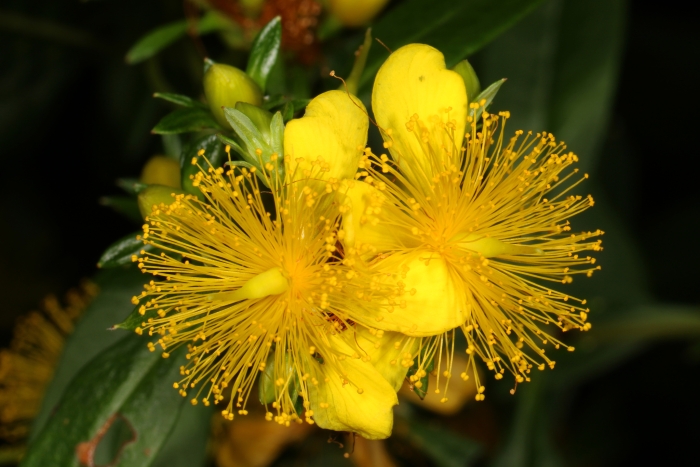Shrubby St. John’s Wort
(Hypericum prolificum)
Shrubby St. John’s Wort (Hypericum prolificum)
/
/

Judy Gallagher
CC BY-SA 4.0
Image By:
Judy Gallagher
Recorded By:
Copyright:
CC BY-SA 4.0
Copyright Notice:
Photo by: Judy Gallagher | License Type: CC BY-SA 4.0 | License URL: http://creativecommons.org/licenses/by-sa/4.0/ | Rights Holder: Judy Gallagher | Publisher: iNaturalist | Date Created: 2018-07-06T10:41:22-07:00 |




























































Estimated Native Range
Summary
Hypericum prolificum, commonly known as Shrubby St. John’s Wort, is a deciduous shrub or subshrub native to open woodlands and forest edges in the Central and Eastern USA. It typically grows up to 2 m (6 ft 7 in) tall and is noted for its dense, rounded form. The plant features showy, bright golden-yellow flowers with five petals each, blooming profusely from June to August. The flowers are prolific in stamens, giving rise to its common name. The ovary is usually three-parted, though variations with up to five parts can occur. This species is not particularly noted for its bark or fruit, but the seed capsules can be somewhat ornamental.
Shrubby St. John’s Wort is valued for its ornamental flowers, which attract pollinators, and its ability to thrive in a range of soil conditions. It is commonly used in naturalistic plantings, as a border shrub, or in pollinator gardens. While it prefers full sun to part shade, it is adaptable to various water regimes, though it does best with consistent moisture. It is generally easy to maintain and can be pruned to shape. However, gardeners should be aware that it can be susceptible to root rot in overly wet conditions and may suffer from rust or leaf spot diseases. Despite these potential issues, its hardiness and adaptability make it a versatile choice for many garden settings.CC BY-SA 4.0
Shrubby St. John’s Wort is valued for its ornamental flowers, which attract pollinators, and its ability to thrive in a range of soil conditions. It is commonly used in naturalistic plantings, as a border shrub, or in pollinator gardens. While it prefers full sun to part shade, it is adaptable to various water regimes, though it does best with consistent moisture. It is generally easy to maintain and can be pruned to shape. However, gardeners should be aware that it can be susceptible to root rot in overly wet conditions and may suffer from rust or leaf spot diseases. Despite these potential issues, its hardiness and adaptability make it a versatile choice for many garden settings.CC BY-SA 4.0
Plant Description
- Plant Type: Shrub, Subshrub
- Height: 1-4 feet
- Width: 1-4 feet
- Growth Rate: Moderate
- Flower Color: Yellow
- Flowering Season: Summer
- Leaf Retention: Deciduous
Growth Requirements
- Sun: Full Sun, Part Shade
- Water: Medium
- Drainage: Fast, Medium, Slow
Common Uses
Bee Garden, Bird Garden, Butterfly Garden, Deer Resistant, Drought Tolerant, Erosion Control, Groundcover, Hedges, Low Maintenance, Salt Tolerant, Showy Flowers
Natural Habitat
native to open woodlands and forest edges in the Central and Eastern USA
Other Names
Common Names: Common St. John’s Wort, Millepertuis Prolifère
Scientific Names: , Hypericum prolificum, Hypericum spathulatum, Hypericum cryptopetalum, Hypericum foliosum, Hypericum kalmianum var. majus, Myriandra ledifolia, Myriandra prolifica, Myriandra prolifica var. spathulata, Myriandra spathulata,
GBIF Accepted Name: Hypericum prolificum L.